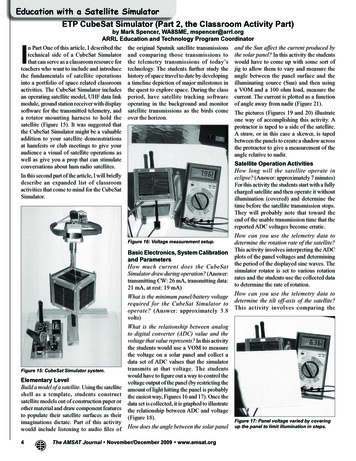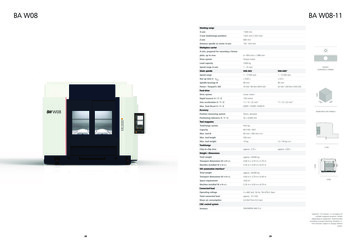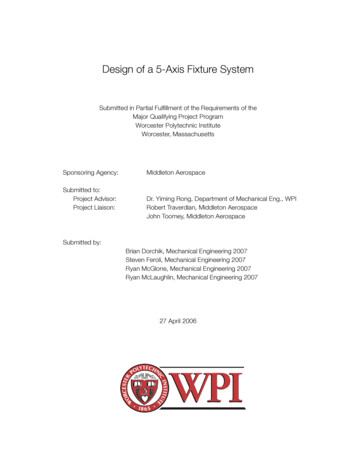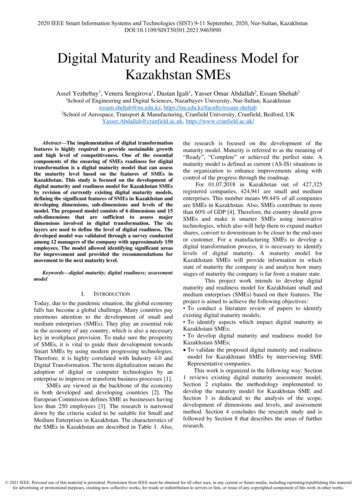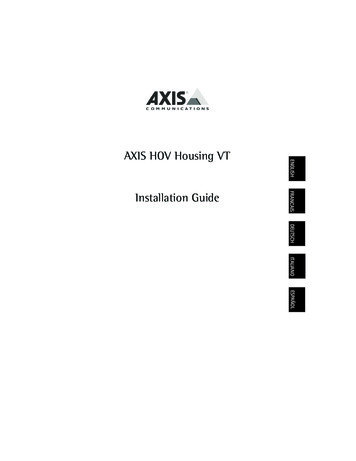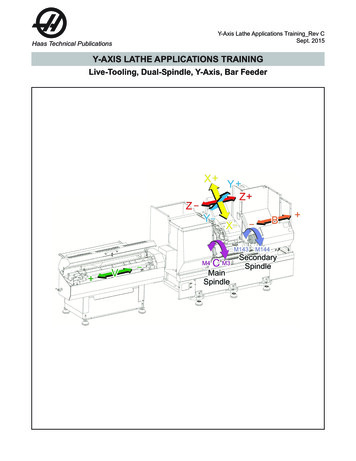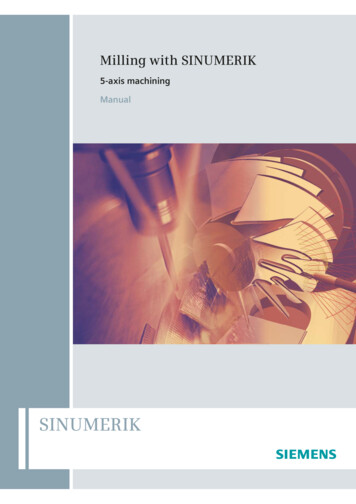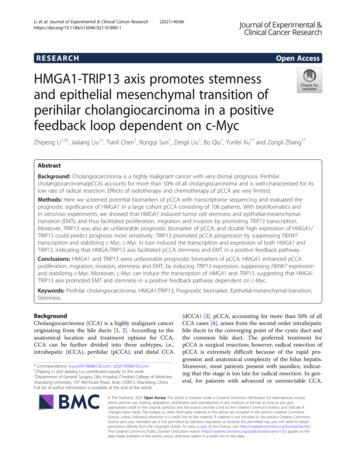
Transcription
Li et al. Journal of Experimental & Clinical Cancer (2021) 40:86RESEARCHOpen AccessHMGA1-TRIP13 axis promotes stemnessand epithelial mesenchymal transition ofperihilar cholangiocarcinoma in a positivefeedback loop dependent on c-MycZhipeng Li1,2†, Jialiang Liu1†, Tianli Chen1, Rongqi Sun1, Zengli Liu1, Bo Qiu1, Yunfei Xu1* and Zongli Zhang1*AbstractBackground: Cholangiocarcinoma is a highly malignant cancer with very dismal prognosis. Perihilarcholangiocarcinoma(pCCA) accounts for more than 50% of all cholangiocarcinoma and is well-characterized for itslow rate of radical resection. Effects of radiotherapy and chemotherapy of pCCA are very limited.Methods: Here we screened potential biomarkers of pCCA with transcriptome sequencing and evaluated theprognostic significance of HMGA1 in a large cohort pCCA consisting of 106 patients. With bioinformatics andin vitro/vivo experiments, we showed that HMGA1 induced tumor cell stemness and epithelial-mesenchymaltransition (EMT), and thus facilitated proliferation, migration and invasion by promoting TRIP13 transcription.Moreover, TRIP13 was also an unfavorable prognostic biomarker of pCCA, and double high expression of HMGA1/TRIP13 could predict prognosis more sensitively. TRIP13 promoted pCCA progression by suppressing FBXW7transcription and stabilizing c-Myc. c-Myc in turn induced the transcription and expression of both HMGA1 andTRIP13, indicating that HMGA-TRIP13 axis facilitated pCCA stemness and EMT in a positive feedback pathway.Conclusions: HMGA1 and TRIP13 were unfavorable prognostic biomarkers of pCCA. HMGA1 enhanced pCCAproliferation, migration, invasion, stemness and EMT, by inducing TRIP13 expression, suppressing FBXW7 expressionand stabilizing c-Myc. Moreover, c-Myc can induce the transcription of HMGA1 and TRIP13, suggesting that HMGATRIP13 axis promoted EMT and stemness in a positive feedback pathway dependent on c-Myc.Keywords: Perihilar cholangiocarcinoma, HMGA1;TRIP13, Prognostic biomarker, ndCholangiocarcinoma (CCA) is a highly malignant canceroriginating from the bile ducts [1, 2]. According to theanatomical location and treatment options for CCA,CCA can be further divided into three subtypes, i.e.,intrahepatic (iCCA), perihilar (pCCA), and distal CCA* Correspondence: xuyunfei1988@126.com; zzlzzl1900@163.com†Zhipeng Li and Jialiang Liu contributed equally to this work.1Department of General Surgery, Qilu Hospital, Cheeloo College of Medicine,Shandong University, 107 Wenhuaxi Road, Jinan 250012, Shandong, ChinaFull list of author information is available at the end of the article(dCCA) [3]. pCCA, accounting for more than 50% of allCCA cases [4], arises from the second-order intrahepaticbile ducts to the converging point of the cystic duct andthe common bile duct. The preferred treatment forpCCA is surgical resection; however, radical resection ofpCCA is extremely difficult because of the rapid progression and anatomical complexity of the hilus hepatis.Moreover, most patients present with jaundice, indicating that the stage is too late for radical resection. In general, for patients with advanced or unresectable CCA, The Author(s). 2021 Open Access This article is licensed under a Creative Commons Attribution 4.0 International License,which permits use, sharing, adaptation, distribution and reproduction in any medium or format, as long as you giveappropriate credit to the original author(s) and the source, provide a link to the Creative Commons licence, and indicate ifchanges were made. The images or other third party material in this article are included in the article's Creative Commonslicence, unless indicated otherwise in a credit line to the material. If material is not included in the article's Creative Commonslicence and your intended use is not permitted by statutory regulation or exceeds the permitted use, you will need to obtainpermission directly from the copyright holder. To view a copy of this licence, visit http://creativecommons.org/licenses/by/4.0/.The Creative Commons Public Domain Dedication waiver ) applies to thedata made available in this article, unless otherwise stated in a credit line to the data.
Li et al. Journal of Experimental & Clinical Cancer Research(2021) 40:86the median overall survival is less than 1 year [5]. Evenafter radical resection, the 5-year overall survival rate isless than 30% [6]. The effects of radiotherapy andchemotherapy of pCCA are very limited, and studies onpCCA are far behind those of other more common tumors such as lung cancer and colon cancer in this era ofprecision treatment [7]. Several reasons can be attributedto, including (i) the prevalence of pCCA is relatively low,making a large cohort difficult to establish; (ii) pCCAspecimens are hard to obtain because of its special anatomical location, resulting in rare reports on pCCAhigh-throughput experiments; (iii) most patients losesurgical opportunity and the survival times are so shortto perform any experimental treatment. Thus, furtherstudies of the pathogenesis and therapeutic options ofpCCA are necessary.Targeted therapy and precision treatments are basedon effective biomarkers and an in-depth understandingof tumor progression. However, this is extremely hard asto pCCA because of the difficulty of specimen obtainment and establishment of large cohort. Even in the lowproportion of patients who underwent resection, rate ofradical resection is very low( 30%) [8]. This increasesthe heterogeneity of surgical treatment and results indifficulties in collecting a homogeneous cohort to verifybiomarkers or treatments. From our experience, we obtained a validation cohort of patients with pCCA whounderwent radical resection (n 106 patients), and confirmed several potential biomarkers of pCCA [9, 10].However, more prognostic biomarkers of pCCA areneeded to predict the post-operational risk and guidethe individual treatment for patients with pCCA.High mobility group A1 (HMGA1) protein is a smallnuclear protein that acts as a structural transcriptionfactor [11]. Under normal conditions, high expression ofHMGA1 can occur during embryogenesis and in normalembryonic stem cells and adult stem cells [12, 13] Inmature differentiated tissues, HMGA1 is barely detected;however, some ectopic events in cancer, such as oncogenic transcription factors, epigenetic changes, andchromosomal translocation events, can induce abnormalup-regulation of HMGA1 [14]. Ectopic expression ofHMGA1 has been widely reported in different tumors,and overexpression of HMGA1 is associated with progression or poor prognosis in several types of cancers,including pancreatic adenocarcinoma [15], lung cancer[16], breast cancer [17], colon cancer [14], gastric cancer[18], and hepatocellular carcinoma [19]. Moreover,HMGA1 has been shown to activate a variety of genesinvolved in tumorigenesis, tumor proliferation, migration, invasion, and epithelial-mesenchymal transition[12]. In iCCA, HMGA1 was expressed and can enhancethe tumorigenicity [20, 21]. However, the clinical significance of HMGA1 in pCCA has not been elucidated.Page 2 of 18Accurate chromosome segregation is essential to avoidchromosomal aneuploidy, which is a common feature ofhuman malignancies, accounting for approximately 90%of human solid tumors and more than 50% ofhematopoietic tumors [22]. As a key modulator ofchromosome segregation, thyroid hormone receptorinteractor 13 (TRIP13) is expressed in various adult tissues and plays key roles in inactivation of the mitoticcheckpoint complex (MCC) [23]. TRIP13 is an oncoprotein in several types of cancers and is abnormallyexpressed in various human tumors, including head andneck cancer, hepatocellular carcinoma, colorectal cancer,breast cancer, etc. [24]. As a central protein in MCC inactivation, TRIP13 promotes tumor progression mainlyby altering the conformation of the terminal macromolecule [25]. Overexpression of TRIP13 in nonmalignantcells can increase the tumorigenicity of the cells; however, the role of TRIP13 in pCCA are still unclear.Accordingly, in this study, we evaluated the expressionand clinical significance of HMGA1 in a large cohort ofpatients with pCCA and examined the oncogenic functions of HMGA1. With in vitro and in vivo experimentsand bioinformatics, we identified TRIP13 as the key protein in HMGA1-induced stemness, EMT and metastasisof pCCA. In addition, we investigated the underlyingmechanism of how HMGA1-TRIP13 axis promoted theprogression of pCCA, and demonstrated that HMGA1TRIP13 axis had a positive feedback loop dependent onc-Myc involvement.Materials and methodsRetrospective cohorts and follow-upThe primary cohort comprised 325 patients who werediagnosed with pCCA at Qilu Hospital of ShandongUniversity and underwent surgical resection from 2013to 2018. A validation cohort consisting of 106 patientswith pCCA was further selected from the primary cohortaccording to the following inclusion criteria: availablepCCA tumor tissues for further study; survival timemore than 1 month; no history of chemotherapy orradiotherapy; and no history of other malignancies. Thebasic information for the primary and validation cohortsis described in Supplementary Table 1. All patient materials were obtained after obtaining informed consent,and the study was approved by the Clinical ResearchEthics Committees of Shandong University.Cells and reagentsHIBEpic human biliary epithelial cells, pCCA cell lines(QBC939 and FRH0201), RBE iCCA cells, and gallbladder cancer cell lines (GBC-SD, NOZ, and SGC-996)were purchased from the Chinese Academy of SciencesCell Bank (Shanghai, China). HCCC-9810 iCCA cellswere purchased from American Type Culture Collection
Li et al. Journal of Experimental & Clinical Cancer Research(2021) 40:86(Manassas, VA, USA). All cell lines were cultured according to the instructions recommended by the cell banks.Anti-HMGA1 antibodies (cat. no. ab129153), antiTRIP13 antibodies (cat. no. ab204331), anti-Fbxw7 antibodies (cat. no. Ab109617), anti-laminB1 antibodies (cat.no. ab16048) and anti- OCT4 antibodies (cat. no.Ab19857) were purchased from Abcam (Cambridge,UK). Anti-c-Myc antibodies (cat. no. YT0991), antiTCF4/TCF12 antibodies (cat. no.YT4580) and antiGAPDH antibodies (cat. no. YM3215) were purchasedfrom ImmunoWay Biotechnology (Plano, TX, USA).Anti-EMT antibodies kit (cat. no. 9782 T) and antiCD44 antibodies (cat. no. 3570S) were purchased fromCell Signaling Technology. All other agents were fromSigma-Aldrich (St. Louis, MO, USA).Tissue microarray (TMA) and immunohistochemistry (IHC)The tissue microarrays (TMA) were made using bufferedformalin-fixed and paraffin-embedded tissue sectionsfrom all the 106 pCCA patients according to our previous report [26]. Histological features of all samples wereconfirmed by hematoxylin and eosin (HE) staining before IHC. Core tissues with a 1.5-mm diameter wereused for TMA construction.For IHC, the slides were submerged in EDTA (pH 9)buffer for optimal antigen retrieval. Primary HMGA1antibody (1:100) or TRIP13 antibody (1:50) was appliedand incubated with the specimens at 4 C overnight. Abiotin-labeled goat anti-rabbit antibody (Zsbio, Beijing,China) was applied for 30 min at room temperature.Subsequently, the slides were incubated with conjugatedhorseradish peroxidase streptavidin. The peroxidase reaction was developed using a 3,3-diaminobenzidine(DAB) solution (Zsbio). The IHC results screened usinga TMA scanner (Pannoramic MIDI; 3DHISTECH,Budapest, Hungary) were evaluated independently bytwo senior pathologists and quantified using Quant Center Software. Quantitative IHC results were comprisedof the score for staining intensity and the percentage ofstained cells. The staining intensity score was defined asnegative (0), weak (1), medium (2), or strong (3). TheIHC score generated by Quant Center software was thesum of the product of the score for staining intensitymultiplied by the percentage of stained cells respectively,according to previous studies [27]. The cohort was divided into low and high expression levels according tothe cut-off values, which were identified as the pointwith the highest sum of the specificity and sensitivity inthe receiver operating characteristic curve [9, 28].Page 3 of 18cDNA was synthesized by reverse transcription and subjected to qRT-PCR using a kit from Toyobo (Osaka,Japan). SYBR Green Master Mix (Toyobo) and a StepOnePlus system (Applied Biosystems, Waltham, MA,USA) were used in this experiment. Glyceraldehyde 3phosphate dehydrogenase (GAPDH) was used as an internal control. The primers used in this study are listedin Supplementary Table 2.Transfection and stable cell linesHMGA1 and TRIP13 short-hairpin RNAs (shRNAs)were constructed using the lentivirus vector LV-5 (GenePharma). The virus particles were harvested 72 h afterco-transfection with the packaging plasmids pGag/pol,pRev, and pVSV-G into HEK-293 T cells using RNAiMate and used to infect pCCA cells with polybrene(multiplicity of infection: 40) to generate correspondingstable cell lines (GenePharma). Full-length HMGA1 andTRIP13 sequences were ligated into the lentivirus vectors LV-GV492 and LV-GV365, respectively (Genechem). Transient transfection of small interfering RNA(siRNA) was realized with Lipofectamine 2000 (ThermoFisher Scientific, Waltham, MA, USA). FBXW7 siRNAswere purchased from Biosune (Shanghai, China), andscrambled sequence was used as a control. Stable celllines with HMGA1 overexpression or knockdown andwith TRIP13 knockdown were selected with 4 μg/mLpuromycin incubation for 7 days. The related sequencesare listed in Supplementary Table 3. The efficiency ofHMGA1/TRIP13/FBXW7 overexpression or knockdownwas assessed using Western blot.Western blot and analysisTotal protein lysates were extracted from tissues or cultured cells using RIPA buffer (phenylmethylsulfonylfluoride/RIPA [1:100]) and used for Western blot. Theprotein concentrations were determined using a BCAProtein Assay Kit (Tiangen Biotech, Beijing, China).Briefly, equal amounts of proteins (40 μg) were loadedonto gels, separated by sodium dodecyl sulfate polyacrylamide gel electrophoresis on 10% gels, and transferredto polyvinylidene difluoride membranes. Membraneswere blocked with 5% nonfat milk and then incubatedwith the anti-HMGA1 (1:10000), anti-TRIP13 (1:200),anti-FBXW7(1:1000), or anti-epithelial-mesenchymaltransition (EMT) antibodies (1:1000) overnight at 4 C.Membranes were washed with TBST and incubated withsecondary antibodies at 37 C for 1 h. Finally, proteinlevels were confirmed and normalized using anti-GAPDH/laminB antibodies.Quantitative real-time reverse transcription polymerasechain reaction (qRT-PCR)Cell proliferation and colony formation assaysTotal RNA from fresh tissues/cells was extracted usingTRIzol reagent (Invitrogen, Waltham, MA, USA), andCell proliferation assays were performed using a CellCounting Kit 8 (CCK-8; Dojindo, Japan) according to
Li et al. Journal of Experimental & Clinical Cancer Research(2021) 40:86the manufacturer’s instructions. For colony formationassays, 1000–1500 pCCA cells were seeded into eachwell of a 6-well plate and cultured in Dulbecco’s modified Eagle’s medium (DMEM) containing 10% fetal bovine serum (FBS) for 14 days. After fixation withmethanol and staining with 0.1% crystal violet, the number of clones was counted under an invertedmicroscope.Wound healing assayFor wound healing assays, treated pCCA cells were cultured in 6-well plates at a density of 3 105 cells/welluntil reaching confluence. A wound was then created inthe center of the cell monolayers using a sterile pipettetip. Phase contrast images were captured at differenttimes, and the percent wound healing was calculated asfollows: healed migrated cell surface area/wound totalsurface area 100%. Image J software was used.Page 4 of 18diameters were measured with an external caliper every3 days as previously described (Z et al., 2019).For in vivo hepatic metastasis assays, 5 105 treatedQBC939 cells were injected into the caudal vein of nudemice (n 6/group). Mice were sacrificed after 5 weeksand examined for hepatic metastases. Optical and pathological images were collected to visualize primary tumorgrowth and metastatic lesion formation. Tumor metastasis was finally confirmed with HE staining by the criteriaincluding tissue atypia (abnormal tissue arrangement,cell morphology), and nuclear atypia (large nuclear, increased mitosis,etc.).All nude mice were maintained under specificpathogen-free conditions in the Experimental AnimalDepartment of Shandong University. All animal experiments were approved by the Clinical Research EthicsCommittees of Shandong University.RNA-seq and computational analysesFor migration assays, 5–10 104 pCCA cells wereseeded in 200 μL of 3% serum medium into the topchambers of inserts (BD Biosciences), and 600 μLmedium with 20% FBS was added to the lower chamber.After incubating for 24–36 h, cells were fixed with 20%methanol for 30 min and stained with 0.1% crystal violetfor 1 h. The cells on the upper surface were removedwith a cotton swab, and the cell number in 10 randomfields was counted from the lower surface. For invasionassays, the upper compartment of the chambers was precoated with 50 μL Matrigel [29].RNA-seq was performed to detect the mRNA expressionprofiles of TRIP13-silenced pCCA cells at GenePharma(China) using the Illumina HiSeq 2500 platform (LC Sciences, Hangzhou, China). HISAT package was used toalign the reads to the genome and generate raw countscorresponding to each known gene (32,331 genes), andString Tie was used to evaluate the expression levels ofmRNAs by calculating fragments per kilobase million(FPKM). Differentially expressed genes were selectedwith fold change 4 and Padj 0.10, and gene ontology(GO) analysis was used for pathway enrichment withCytoscape (ClueGo) for data.Soft agar colony forming assayLuciferase reporter assayFor three-dimensional (3D) sphere culture, soft agar colony formation assays were used. Briefly, low-meltingtemperature agarose containing 10% FBS and DMEMwas diluted to a final concentration of 0.6% and solidified at 4 C in wells of a 6-well plate [30]. Next, 10,000cells/well were immediately plated in the top layer oflow-melting-temperature agarose containing 10% FBS ata final concentration of 0.3%. Cells were covered with 1mL DMEM per well and incubated at 37 C with 5%CO2 for 1 week. Medium was changed every other day,and cells were imaged. Colonies were counted using anOlympus IX81 inverted microscope. At least three independent experiments were performed in triplicate.QBC939 cells (5 104 cells/well) were seeded in 24-wellplates in triplicate and allowed to attach for 24 h. Cellswere then transiently transfected with the indicated plasmids and the pRL-TK Renilla luciferase plasmid usingLipofectamine 2000 (Invitrogen). Forty-eight hours aftertransfection, the cells were harvested and processedusing a Dual Luciferase Reporter Assay Kit (Promega,Madison, WI, USA) according to the manufacturer’s instructions. Luciferase activity was evaluated using aDual-Luciferase Reporter Assay System (Beyotime) withRenilla luciferase as internal control to eliminate thechaos of transfection efficiency. The target DNA fragment genes (HMGA1/TRIP13/c-Myc) were cloned intothe pcDNA3.1 or pGPU6 vector. The empty pcDNA3.1basic vector was used as the negative control, and thepcDNA3.1 promoter vector, containing the gene ofTRIP13,FBXW7 or HMGA1 promoter upstream of theluciferase gene respectively, was used as the positivecontrol. The human promoter regions generated byPCR-amplification, were cloned into the KpnI/HindIIIsites of the PGL3-basic dual luciferase reporter plasmidCell migration and invasion assaysXenograft modelsFemale BALB/c nude mice (5 weeks of age) were purchased from GemPharmatech Company (Nanjing,China). Stable clones of pCCA (QBC939) cells, transfected with shHMGA1, HMGA1, HMGA1/shTRIP13, orthe control vector, were subcutaneously injected into theright flanks of nude mice (n 6/group). Tumor
Li et al. Journal of Experimental & Clinical Cancer Research(2021) 40:86to generate TRIP13,FBXW7 or HMGA1 luciferase reporters. The reporter gene activity was determined bynormalization of the firefly luciferase activity to Renillaluciferase activity. The promoter region sequences ofHMGA1/TRIP13/c-Myc were provided in Supplementary Table 4.Statistical analysisSPSS 17.0 and GraphPad Prism 5 software package version 5.03 (GraphPad Prism Software, San Diego, CA,USA) were used to perform statistical analyses. The χ2test was used to assess the correlations betweenHMGA1/TRIP13 and clinicopathological factors. TheKaplan-Meier method and log-rank test were used to determine cumulative overall survival rates and survivalcurves, respectively. The independent prognostic factorswere analyzed by multivariate analysis with the Coxregression model. T-test, one- or two-way analysis ofvariance (ANOVA) were used for statistical comparisonsbetween groups. Results with P values of less than 0.05were considered significant.ResultsExpression and clinical significance of HMGA1 in pCCATranscriptome sequencing profiles in eight pCCA tissues and paired tumor-adjacent bile duct tissues wereused to identify differentially expressed genes inpCCA (BioProject accession PRJNA517030 andPRJNA547373). According to the criteria set as foldchange 4 and Padj 0.10, 180 genes were selected(Supplemental Table 5). Among the HMG family,only HMGA1 was significantly upregulated in pCCAscompared with adjacent bile duct tissues (Fig. 1a).Moreover, qRT-PCR with 18 pCCA pairs (Fig. 1b)and WB with four pCCA pairs further confirmedHMGA1 upregulation in pCCA (Fig. 1c). In a retrospective cohort of patients with pCCA radical resection (n 106), the expression and localization ofHMGA1 were detected with IHC. HMGA1 wasmainly expressed in the nucleus (Fig. 1d), consistentwith its function as a transcription factor.Moreover, high expression of HMGA1 was significantly associated with positive lymphatic invasion andadvanced TNM stage (Fig. 1e), indicating that HMGA1may promote the invasion of pCCA. In overall survivalcurves, high HMGA1 expression was correlated with unfavorable prognosis (Fig. 1f; Supplementary Table 6),suggesting that HMGA1 may be a prognostic biomarkerof pCCA. Cox-regression hazard models confirmed thatHMGA1 tended to be an independent prognostic biomarker of pCCA, but the statistical significance is notthat notable (P 0.072) (Supplementary Table 6).Page 5 of 18HMGA1 promoted the proliferation, invasion, stemness,and EMT in pCCA cellsNext, we measured HMGA1 expression in various biliary cell lines including normal biliary epithelium cellline HIBEpiC, the pCCA cell lines QBC-939 and FRH0201, iCCA cell lines RBE and HCCC-9810, gallbladdercarcinoma cell lines GBC-SD, NOZ and SGC-996.HIBEpiC cells showed significantly lower HMGA1 expression, whereas the expression of HMGA1 was increased in all these cell lines (Fig. 1g, SupplementaryFigure 1A). In both QBC-939 and FRH-0201 cells,HMGA1 was silenced with two independent shRNAs oroverexpressed with a lentivirus carrying the HMGA1cDNA (Supplementary Figure 1B and 1C). CCK8 andcolony formation assays demonstrated that HMGA1knockdown significantly impaired proliferation, whereasHMGA1 overexpression promoted pCCA proliferation(Fig. 1h and i, Supplementary Figure 2A). Stable QBC939 cells with HMGA1 knockdown or overexpressionwere injected subcutaneously to establish xenografts inmice. The tumor volume and weight of xenografts wereextensively decreased by HMGA1 knockdown and increased by HMGA1 overexpression (Fig. 1j and k, Supplementary Figure 2B). In addition, wound healing andtranswell assays demonstrated that HMGA1 promotedthe migration and invasion of QBC-939 and FRH-0201cells (Fig. 1l and m, Supplementary Figure 2C and D).All above results indicated that HMGA1 had extensiveinfluences on pCCA progression including proliferation,migration and invasion.To explain this multiple functions of HMGA1 onpCCA progression, the effects of HMGA1 on cell stemness and EMT were investigated because previous studysuggested HMGA1 is an important factor involved incell stemness and EMT [13]. Sphere-formation assaysshowed that HMGA1 upregulation increased pCCAstemness, whereas HMGA1 downregulation suppressedstemness (Fig. 1n, Supplementary Figure 2E). Moreover,E-cadherin expression was decreased, and other EMTbiomarkers including N-cadherin, Vimentin, Snail,Twist-1, and Claudin-1, were upregulated followingHMGA1 overexpression, and downregulated followingHMGA1 knockdown (Fig. 1o and p). These results indicated that HMGA1 played important roles in stemnessand EMT of pCCA, which thus influenced proliferation,migration and invasion.HMGA1 promoted the transcription and expression ofTRIP13In mRNA sequencing of eight pairs of pCCA and normalbile duct tissues, 180 genes were up-regulated (Fig. 2a,Supplementary Table 5). In previous study, a total of 21proteomic signatures regulated by HMGA1 in breast cancer were reported, and three of them (KIFC1, LRRC59,
Li et al. Journal of Experimental & Clinical Cancer ResearchFig. 1 (See legend on next page.)(2021) 40:86Page 6 of 18
Li et al. Journal of Experimental & Clinical Cancer Research(2021) 40:86Page 7 of 18(See figure on previous page.)Fig. 1 HMGA1 enhanced oncogenic progression of pCCA cells. a Left: Heatmap of HMG gene expression profiles in eight pairs of pCCA tissuesand adjacent normal tissues. Right: FPKM of HMGA1 in pCCA and adjacent normal tissues were shown. Data were were analyzed by paired t tests(b) HMGA1 mRNA expression in 18 paired pCCA and adjacent normal duct tissues, detected by qRT-PCR. P value was calculated with paired ttests. c Up: HMGA1 expression in four randomly-selected pairs of pCCA tissues (T) and adjacent normal tissues (N), detected by Western blot.Bottom: quantification of bands in the left panel. d Representative images of immunohistochemical staining for low/high expression of HMGA1 inthe tissue microarray (top: 100 magnification, scale bar, 200 μm; bottom: 400 magnification, scale bar, 50 μm). e Correlation between HMGA1expression and clinicopathological features (Chi-square tests). f Kaplan-Meier survival analysis in patients with pCCA with low (n 35) and high(n 71) HMGA1 expression (cut-off: 77.4). g HMGA1 expression in human cholangiocarcinoma cell lines, gallbladder carcinoma cell lines, andintrahepatic bile duct cell line HiBEpiC. (H) HMGA1 was silenced in QBC939 and overexpressed in FRH0201, and the effects of HMGA1 on pCCAcell proliferation were measured by CCK-8 assays. i effects of HMGA1 on colony formation in QBC939 and FRH0201 cells after knockdown inQBC939 or overexpression in FRH0201. j QBC939 cells with stable HMGA1 knockdown (up) or overexpression (bottom) were subcutaneouslyinjected to nude mice for xenograft model (n 6/group). k Tumor volumes in xenografts established using cells infected with lentivirus carryingscrambled shRNA, shHMGA1, empty vector, or GV492-HMGA1. l,m The effects of HMGA1 on migration and invasion were detected with woundhealing assay(l) and transwell assay(m) after silencing HMGA1 in QBC939 or overexpressing HMGA1 in FRH0201 cells. n Effects of HMGA1 onstemness was detected by 7-day-sphere formation activity with stable HMGA1-silencing or HMGA1-overexpressing QBC939 cells. o,p Effects ofHMGA1 on EMT were detected by Western blot after silencing HMGA1 in QBC939(o) and overexpressing HMGA1 in FRH0201 cells(p). *P 0.05,**P 0.01, and ***P 0.001 compared with the corresponding control group. Data are shown as means S.D., and statistical significance wasanalyzed with one-way ANOVA(h and k) or T-test. Analyzed data were from three independent experiments, and each subgroup was performedat least in triplicate (c,g, h,i, l-p)and TRIP13) were verified to promote breast cancer progression [31]. Interestingly, TRIP13, was identified by bothour mRNA sequencing and previous proteomic HMGA1linked signatures (Fig. 2a, Supplementary Table 5). ThemRNA levels of KIFC1, LRRC59, and TRIP13 were evaluated using 36 cases of CCA from The Cancer GenomeAtlas (TCGA) database (https://tcga-data.nci.nih.gov/tcga/), and their correlations with HMGA1 were analyzed (Fig.2b). KIFC1 and TRIP13 showed positive correlation withHMGA1 of the 36 CCAs, but qRT-PCR showed that onlyTRIP13 expression was regulated by HMGA1 in QBC-939(Fig. 2c). Our qRT-PCR results with 18 pCCA tissues alsosupported the strong positive correlation betweenHMGA1 and TRIP13 (Fig. 2d). TRIP13 expression was detected by IHC in 106 cases in pCCA TMA (Fig. 2e). TheIHC score of TRIP13 was significantly associated with theIHC score of HMGA1(Fig. 2f), and patients with highHMGA1 expression had high TRIP13 expression (Fig. 2g).In QBC-939 cells, regulation of HMGA1 expression led tocorresponding changes of TRIP13 (Fig. 2h). Finally, luciferase assays demonstrated that HMGA1 promoted thetranscription of TRIP13 in pCCA cells (Fig. 2i) and 293 Tcells (Fig. 2j). All above results suggested that HMGA1 induced TIRP13 expression via promoting its transcription.TRIP13 promoted cancer progression and was correlatedwith poor prognosis in pCCATRIP13 expression was highest in QBC-939 cells amongthe detected biliary cell lines including HIBEpiC, QBC939, FRH-0201, RBE, HCCC-9810, GBC-SD, NOZ andSGC-996 (Fig. 3a). Evaluation of TRIP13 expression byqRT-PCR in 18 pairs of pCCA tissues and WB in fourpairs of pCCA tissues demonstrated that TRIP13 wasupregulated (Fig. 3b and c). In the validation cohort, patients with high expression of TRIP13 had poorerprognoses than those with low expression(P 0.019)(Fig. 3d). Intriguingly, high expression of both TRIP13and HMGA1 was a more sensitive prognostic factorthan TRIP13 or HMGA1 alone (P 0.0002) (Fig. 3d).Multivariate analysis also identified TR
ter Software. Quantitative IHC results were comprised of the score for staining intensity and the percentage of stained cells. The staining intensity score was defined as negative (0), weak (1), medium (2), or strong (3). The IHC score generated by Quant Center software was the sum of the product of the score for staining intensity

